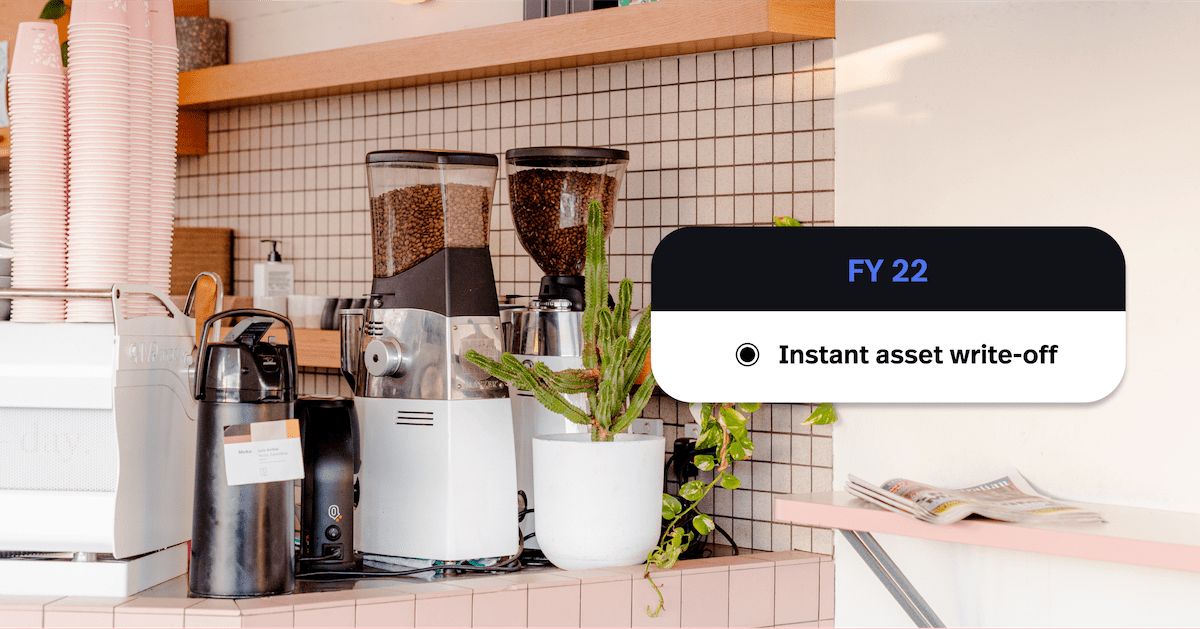
With the end of the financial year in sight, many hospitality businesses are gearing up to file their tax returns.
This year, business owners can expect to claim several tax offsets, thanks to the federal government extending the instant asset write-off scheme and introducing temporary full expensing.
But what’s the difference between an instant asset write-off and temporary full expensing? Is your business eligible, and how do you apply?
- What is an instant asset write-off?
- What is temporary full expensing (TFE)?
- What does this mean for hospitality venues?
- How does an instant asset write-off work?
- How to apply for an instant asset write-off
Stay across the latest news in hospitality
Subscribe to our monthly newsletter to keep up to date with the latest in hospo. From industry news to community stories, insights, tips, trends and stats.
What is an instant asset write-off?
An instant asset write-off allows eligible businesses to claim a tax deduction for any assets purchased and used for business purposes.
The instant asset write-off can be used for multiple assets if the cost of each asset is less than the relevant threshold. The write-off also applies to both new and second-hand assets.
Assets must be purchased and used in the year that the write-off is claimed.
What has changed since the 2020-2021 budget?
In previous years, to be eligible for the instant asset write-off, your business must meet the following criteria:
- Assets must first have been used (or installed ready for use) from 12 March 2020 until 30 June 2021 and purchased by 31 December 2020.
- Assets must be under the $150,000 threshold.
- Businesses must have an aggregated turnover of less than $500 million.
The instant asset write-off does not apply to assets purchased or installed after 7:30 pm on 6 October 2020. For assets purchased after this date, business owners must apply for tax relief under the temporary full expensing (TFE) scheme.
The federal government introduced Temporary Full Expensing (TFE) to offer businesses more financial relief in the wake of the pandemic. In essence, TFE removes the previous instant asset write-off threshold of $150,000.
The scheme will now cover the 2022/23 tax year, and eligible businesses can claim an immediate tax deduction for the total cost of qualifying assets installed or in use after 6 October 2020 and before June 30, 2023.
What is Temporary Full Expensing (TFE)?
Businesses can now claim an asset write-off, no matter the asset’s cost, as long as it’s used (or installed for use) for business purposes within the year the claim is made. This is called temporary full expensing (TFE).
To be eligible for TFE, your business must meet the following criteria:
- An Australian business with an aggregated turnover of less than $5 billion.
- The eligible new assets must be purchased and first used or installed, ready for use between 7.30 pm AEDT on 6 October 2020 and 30 June 2023.
For businesses with an aggregated turnover of less than $50 million, TFE also applies to eligible second-hand depreciating assets. It is also possible for businesses to deduct the cost of improvements to an eligible asset.
If TFE does not apply to your circumstances or your business isn’t eligible, you may still be able to claim the deduction under the instant asset write-off scheme mentioned earlier. To apply for the scheme, the asset(s) must have been:
- Purchased by 31 December 2020
- First used or installed ready for use before 30 June 2021
What are the key dates for asset cost thresholds?
Instant asset write-off thresholds have changed multiple times over the years. To ensure you are claiming an asset under the correct date and threshold, please refer to the below:
- No cap (7.30pm 6 October 2020 – 30 June 2023)
- $150,000 (12 March 2020 – 30 June 2021)
- $30,000 (7:30pm 2 April 2019 – 11 March 2020)
- $25,000 (29 January 2019 – before 7.30pm 2 April 2019)
- $20,000 (7.30pm 12 May 2015 – 28 January 2019)
- $1,000 (1 January 2014 – 7.30pm 12 May 2015)
- $6,500 (1 July 2012 – 31 December 2013)
- $1,000 (1 July 2011 – 30 June 2012)

What does this mean for hospitality venues?
Instant asset write-offs and TFE allow hospitality businesses to make investments now instead of at a future date. Not only do these measures help to stimulate the economy in the wake of the pandemic, but they also encourage business growth by providing the means to support business expansion.
Examples of tax-deductible assets for hospitality businesses
Instant asset write-offs and TFE only apply to depreciating assets. A depreciating asset is an item with a limited effective life (it won’t work as expected forever) and can decline in value (depreciate) over time.
Examples of depreciating assets that may be purchased and used by hospitality businesses include:
- Tools and equipment, e.g. microwaves, ovens, coffee machines, fridges
- Technology, e.g. computers, laptops, tablets, bump screens, printers and EFTPOS terminals
- Furniture, e.g. chairs, tables, sofas
- Motor vehicles, e.g. cars, motorcycles and delivery vans (there are car limits for each financial year. For 2020/21, it’s $59,136, and for 2021/22, it’s $60,733)
What are the exceptions?
As the scheme only covers depreciating assets, certain exceptions do not qualify and are excluded from the scheme. These include (but are not limited to):
- Capital works (works undertaken to create a new asset or space or change the use, function or layout of an existing asset or area, e.g. structural improvements).
- Horticultural plants (a horticultural plant is a live plant cultivated or propagated for its products, e.g. a grapevine).
- Intangible assets (an asset that is not physical, e.g. a franchise).
- Assets that are leased out or expected to be leased out for more than 50% of the time on a depreciating asset lease
- Software allocated to a software development pool. Special rules apply to in-house software acquired or developed for business use. These rules don’t apply to payments made to use software in your business, such as POS software.
- Land and buildings
Please visit the Australian Taxation Office (ATO) website for more information on excluded assets.
Where can hospitality venues purchase eligible assets?
Before making any significant purchases, it’s essential to determine if the asset is eligible for a write-off and how the asset will impact your business. The instant asset write-off and TFE schemes are designed to incentivise businesses to invest and grow rather than reduce any taxable income.
Therefore, any decision you make should be based on your current business needs and long-term goals, as purchasing significant assets can impact your short term finances and cash flow.
With this in mind, there are several suppliers that provide hospitality businesses with equipment that’s eligible for an instant asset write-off.
If you’re looking to upgrade your technology, most POS providers have hardware stores where you can purchase new iPads, printers, cables and more.
Or, if you’re planning to invest in new kitchen or bar equipment, SilverChef has a wide range of equipment available for purchase, rent or lease-to-buy on tailored finance plans.
Note: only assets purchased outright are eligible for the instant asset write-off.
How does an instant asset write-off work?
There are several ways an instant asset write-off can work, and this will depend on your total aggregated turnover, the number of assets purchased (and used) within the tax year and the total sum of the assets.
Here’s an example of how the instant asset write-off can be used to reduce the taxable income of a restaurant.
A well-established restaurant in Sydney has an annual turnover of $2.4 million. In December 2021, the restaurant owner decided to upgrade some of the old kitchen equipment, invest in several herb plants, refurbish the main dining room and upgrade the iPads for their POS system.
$65,000 was spent on kitchen equipment, $10,000 was spent on new furniture for the dining room, $10,000 was spent on second-hand furniture and $6,000 was spent on new iPads – totalling $91,000
When preparing a tax return for the tax year that the assets were purchased (2021-22), the restaurant owner is entitled to claim $91,000 as an immediate tax deduction for that financial year under the TFE scheme.
As the restaurant’s aggregated turnover is less than $50 million, it’s eligible to claim for second hand depreciating assets. However, if the restaurant had a turnover of more than $50 million, it could not claim for any second-hand assets.
So, using the above example, if a restaurant had an annual turnover of $51 million, they’d only be entitled to claim $81,000 – as the $10,000 for the second-hand dining room furniture would not be eligible.

How to apply for an instant asset write off
Instant asset write-offs and TFE are deducted from your taxable income; therefore, applying to both schemes is done during your annual tax return.
What information is required for a claim?
When filling out your tax return, you’ll need to include the following information:
- Information about your aggregate turnover
- The number of assets you’re claiming temporary full expensing for – there is no limit to the number of assets that can be deducted under the scheme. However, assets must meet the eligibility criteria.
- The total amount of your temporary full expensing deduction – this would be the sum of all eligible assets purchased after 6 October 2020.
Remember: all businesses will have to hold an ABN or ACN to be considered, and you must keep your proof of purchase, receipts and tax invoices for any assets claimed.
The information contained in this article was correct at the time of writing, May 2022. Government legislation is subject to change, so please refer to the ATO website for information on instant asset write-offs and TFE.

News you care about. Tips you can use.
Everything your business needs to grow, delivered straight to your inbox.


